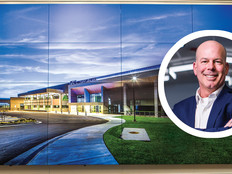Schools Mix One-to-One with a Helping of BYOD
Like many school districts, the Waxahachie Independent School District is always looking for ways to provide the best educational experience for its students, at the most reasonable cost. Technology — in particular, mobile technology — is a key component of the learning atmosphere leaders want to create in this 13-school district about 30 miles south of Dallas.
But embracing a full-blown one-to-one strategy, in which each student has a notebook computer or tablet for accessing online information, takes resources. In order to get technology into students' hands without breaking the bank, WISD took a hybrid approach to one-to-one: Some students use devices provided by the district, while others use their own.
After spending many months investigating students' technology needs and preferences, district leaders discovered that "most of our kids already had mobile devices — and better ones than the district could provide," says Robert Keith, WISD's former director of technology.
With that understanding, WISD decided that local funds would be adequate to pay for the technology and infrastructure required to realize its particular brand of one-to-one, which it calls iNation. That was no small realization. It didn't make sense to use a bond to pay for the program, Keith explains, because the lifecycle of technology moves much faster than a 30-year bond.
Moving Forward
Technology's proliferation isn't universal, however, and for some students, the so-called digital divide is very real.
"There is an assumption that every kid has a device," says Bob Moore, founder and chief consultant of the education and technology consulting firm RJM Strategies.
There's also an assumption that supporting devices is easy. "Imagine a classroom in which you have five, six, seven or eight operating systems and an almost unlimited variety of brands of devices and screen sizes," Moore continues. "How can that class have a consistent learning experience?"
When students lack their own devices, as is the case in many districts, a hybrid approach to one-to-one learning makes sense. But it's of little use if it isn't well-integrated into the education environment — or if it doesn't have teacher buy-in.
WISD officials understand that technology is just a tool for meeting the district's instructional needs. As they prepared to launch the iNation initiative, the IT staff and teachers worked together to select the necessary software and devices and plot the rollout.
The team then planned for and implemented the network upgrades that would be needed to ensure adequate wireless access for both student-owned and district-provided devices.
Building out network capacity may be the easiest upgrade, once funding is clear. Keith suggests that schools plan for growth, but also build in "some legacy support" so older devices don't get locked out. Keith and his team provided wireless coverage for about 1,000 access points to ensure that the network was robust enough to handle the load from so many mobile devices.
96% The percentage of Waxahachie Independent School District students who expressed willingness in an anonymous, in-class survey to use a personal mobile device in the classroom
To make the hybrid model work, WISD had to insist on a certain level of uniformity among district-provided devices. Teachers were given Samsung Chromebooks and access to Google Apps for Education. Each elementary classroom is equipped with five to seven Google Nexus 7 tablets or Samsung Chromebooks for student use, depending on the grade level. Students in middle school and high school, who are allowed to bring their own devices, use Google Apps. The lower cost of Google's hardware and software solutions has been critical to helping WISD sustain its technology plan, Keith notes.
In the past, students who didn't have personal devices used district-supplied Chromebooks, which were kept at school.
But as WISD leaders plan for the 2014–2015 school year, they are considering whether to allow these students to take the devices home for 24/7 use.
Now, when Keith visits classrooms, students at all levels are engrossed in their learning. "Kids are so excited about technology, they don't even realize they are learning," he says.
Attention to Policy
North Carolina's Onslow County School System has been allowing students in some schools to bring their own mobile devices since 2012. The district also provides devices for students who don't have them so teachers can create one-to-one classrooms. According to IT Director Stacy Lee, the district has had a process in place for years to cycle older devices into classrooms to fill gaps in access.
When district leaders decided to roll out a BYOD program to schools that wished to participate, they focused mainly on "policy-type decisions," such as student-use agreements and other policies to protect both the district and its students, Lee continues. (Seventeen of the district's 37 schools chose to allow students to bring and use personal devices in class.) They also realized that it would be important to explain to students and parents what types of personal devices would work in schools.
"We gave some recommendations for what the device needed to have; if it needed to have Flash to run a certain program within the school, for example," Lee says. "We didn't make it a requirement — it was a recommended list."
IT staff then ran trials in the schools to test their networks and teachers' comfort level with the strategy. Teachers now apply for technology tools in their classrooms. That way, the district ensures that their use of the technology is vetted and well-integrated into lesson plans, he explains.
Over the long run, it's important that teachers get the professional development they need to teach in a multidevice, one-to-one classroom. In addition to honing their own technical skills, teachers need the proper IT support to troubleshoot multiple operating systems.
After all the planning, professional development and technology upgrades, districts are ready to let students bring their own devices to school and have them commingle with school-owned devices in a cohesive, one-to-one environment.
For WISD, the hybrid approach has proved to be the best one: "It's working out just as we planned," Keith says.
Stay Safe
A network that serves multiple devices in a school must include robust security measures. "One little change can have a domino effect across the district," says Bob Moore, founder and chief consultant of the education and technology consulting firm RJM Strategies.
Security updates and new apps can, in fact, punch holes in a network if IT leaders aren't careful.
To prevent unintended consequences, districts should ask students not to install software updates — whether on their devices or the school's — until the security staff has vetted them. They also should consider requiring that only certain apps be used on school premises, or creating a list of apps that aren't allowed to access the district network. Such measures would have to be written into student agreements for participating in the hybrid program, and students would need frequent reminders.
In the Onslow County (N.C.) School System, students access the Internet through a virtual LAN, says IT Director Stacy Lee. This allows the district to fulfill its mandate to protect students — as well as its network — from harmful Internet content."As long as students are on our network, they're fully filtered and protected," he says.







